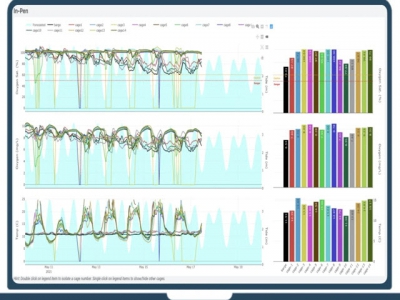New technology from Scoot Science promises to simplify ocean forecasting

Scoot Science has recently launched its SeaState dashboard, a new ocean forecasting tool that lets producers see what’s happening below the water’s surface in real time, and provides forecasts of the days ahead.
Example of SeaState's in-pen data visualisation
Scoot Science is simplifying ocean observing for aquaculture companies globally and unlocking the potential for forecasting ocean events with its SeaState dashboard. SeaState software unifies in-pen environmental data with publicly available oceanographic and meteorological data in a web-based dashboard to make the oceans more manageable, predictable, and insurable.
“Fish farming groups have a high tolerance for unconstrained risk on the water. They’ve done an excellent job monitoring the oceans and yet still consider many ocean risks—like low oxygen waters, large temperature swings, and plankton blooms—unpredictable," says Scoot Science CEO Jonathan LaRiviere, who has a PhD in Ocean Sciences from the University of California, Santa Cruz.
"We have the tools to constrain those risks and we’re working with farms to increase lead time for extreme ocean events. We’re doing short-term forecasting on the individual farm level and also looking at the longer term trends affecting regional-scale aquaculture,” he said.

SeaState's visualisations allow producers to easily track oxygen concentrations and water quality parameters
LaRiviere, along with co-founder Evan Goodwin who has an MS in Physical Oceanography, have assembled a team of oceanographers, agro-economists, data scientists, and software engineers to collect and distil scarce proprietary data with the tools of modern oceanography and project it onto a platform that helps businesses understand and adapt to a changing ocean.
A diverse set of data integrations and a hardware-agnostic approach to ocean observing lay the foundation for Scoot’s SeaState platform. SeaState unifies multiple disparate data systems on a farm with the surrounding environmental conditions to give farmers a window into what’s happening below the surface of the water historically, in the present moment and in the future. Behind the scenes, SeaState is streamlining a complex system of cutting edge marine data visualisation tools layered with numerical ocean models and statistical analysis of the waterways. The result is a dashboard that allows farmers to quickly quantify predictable risks in the ocean that threaten marine life.
Ultimately, we see this as an opportunity for farms to protect their most valuable assets—the fish and seafood they’re raising.
SeaState’s forecasting models are focused on providing an early warning of extreme ocean events. Through increased lead-time farms are able to implement mitigation efforts and dramatically reduce losses. After an event, farms use SeaState to perform forensic audits and are able to identify specific actions that yielded the best results for fish welfare. In real time, Scoot Science is processing over 250,000 data points from each farm daily and is quantifying ocean dynamics from surface to seafloor.
“SeaState is an asset for ocean-based aquaculture companies in any country. It will help these businesses mitigate the effects of climate change and other catastrophic incidents like algal blooms,” says LaRiviere. “Ultimately, we see this as an opportunity for farms to protect their most valuable assets—the fish and seafood they’re raising.”
Có thể bạn quan tâm
 Breeding breakthrough for tilapia in low oxygen systems
Breeding breakthrough for tilapia in low oxygen systems Tilapia breeders who aim to produce fish that cope well in aquaculture systems with low dissolved oxygen levels should consider a two-stage selection programme.
 Lessons from China - the future of IMTA
Lessons from China - the future of IMTA Integrated multi-trophic aquaculture (IMTA) is proving its worth in Sungo Bay in China, with numerous studies to support its environmental and economic benefits
 Breeding tougher tilapia
Breeding tougher tilapia A new genetic discovery could enable tilapia breeders to produce healthier and more resilient fish.